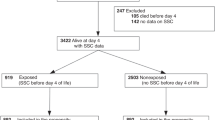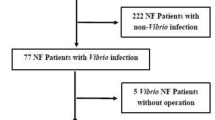Abstract
Exfoliative skin diseases of the neonate are relatively rare but when present require rapid diagnosis and treatment to decrease morbidity and mortality associated with these entities. We present the case of a 795 g premature male infant who developed exfoliative lesions on day of life 66. Skin and blood cultures were obtained and intravenous antibiotics initiated. Results of a Tzanck smear suggested toxic epidermal necrolysis (TEN), so the infant was emergently transferred to a local children's hospital with burn unit capabilities for further care. Further histopathological evaluation of the skin biopsy confirmed the diagnosis of staphylococcal scalded-skin syndrome (SSSS). The desquamation ceased 24 h after the initiation of antibiotic therapy, and the skin lesions resolved within 10 days. We discuss the pathogenesis of SSSS and TEN and highlight the importance of early diagnosis so appropriate treatment can be initiated.
This is a preview of subscription content, access via your institution
Access options
Subscribe to this journal
Receive 12 print issues and online access
$259.00 per year
only $21.58 per issue
Buy this article
- Purchase on Springer Link
- Instant access to full article PDF
Prices may be subject to local taxes which are calculated during checkout


Similar content being viewed by others
References
Amagai M, Matsuyoshi N, Wang Z, Andl C, Stanley J . Toxin in bullous impetigo and staphylococcal scalded-skin syndrome targets desmoglein1. Nat Med 2000; 6: 1275–1277.
Hanakawa Y, Schechter NM, Lin C, Garza L, Li H, Yamaguchi T et al. Molecular mechanisms of blister formation in bullous impetigo and staphylococcal scalded skin syndrome. J Clin Invest 2002; 110: 53–60.
Lyell A . Toxic epidermal necrolysis: an eruption resembling scalding of the skin. Br J Dermatol 1956; 68: 355–361.
Lyell A, Dick HM, Alexander JO . Outbreak of toxic epidermal necrolysis associated with staphylococci. Lancet 1969; i: 787–789.
Wolkenstein P, Revuz J . Toxic epidermal necrolysis. Dermatol Clin 2000; 18: 485–495.
McGee T, Munster A . Toxic epidermal necrolysis syndrome: mortality rate reduced with early referral to regional burn center. Plast Reconstr Surg 1998; 102: 1018–1022.
Makhoul IR, Kassis I, Hashman N, Sujov P . Staphylococcal scalded skin syndrome in a very low birth weight premature infant. Pediatrics 2001; 108: e16.
Hoffmann R, Lohner M, Bohm N, Schaefer HE, Letitis J . Staphylococcal scalded skin syndrome and consecutive septicaemia in a preterm infant. Pathol Res Pract 1994; 190: 77–81.
Peters B, Hentschel J, Mau H, Halle E, Witte W, Obladen M . Staphylococcal scalded-skin syndrome complicating wound infection in a preterm infant with postoperative chylothorax. J Clin Microbiol 1998; 36: 3057–3059.
Siaman L, Jakob K, Holmes KW, Whittier S, Garzon M, Rago J et al. Molecular epidemiology of staphylococcal scalded skin syndrome in premature infants. Pediatr Infect Dis J 1998; 17: 329–334.
Itani O, Crumb R, Mimouni F, Tunnessen Jr WW . Picture of the month. Ritter's disease (neonatal staphylococcal scalded-skin syndrome). Am J Dis Child 1992; 146: 425–426.
de Groot R, Oranje AP, Vuzevski VD, Mettau JW . Toxic epidermal necrolysis probably due to Klebsiella pneumoniae sepsis. Dermatologica 1984; 169: 88–90.
Hawk RJ, Storer JS, Daum RS . Toxic epidermal necrolysis in a 6-week-old infant. Pediatr Dermatol 1985; 2: 197–200.
Scully MC, Frieden IJ . Toxic epidermal necrolysis in early infancy. J Am Acad Dermatol 1992; 27: 340–344.
Lohmeier K, Megahed M, Schulte KW, Stannigel H, Mayatepek E, Schroten H . Toxic epidermal necrolysis in a premature infant of 27 weeks' gestational age. Br J Dermatol 2005; 152: 150–151.
Author information
Authors and Affiliations
Corresponding author
Additional information
Author disclosure: Drs Coleman and Dobson do not have any financial relationships relevant to this article. The views expressed in this article are those of the authors and do not reflect the official policy of the Department of Army, Department of Navy, Department of Defense or US Government.
Rights and permissions
About this article
Cite this article
Coleman, J., Dobson, N. Diagnostic dilemma: extremely low birth weight baby with staphylococcal scalded-skin syndrome or toxic epidermal necrolysis. J Perinatol 26, 714–716 (2006). https://doi.org/10.1038/sj.jp.7211599
Received:
Revised:
Published:
Issue Date:
DOI: https://doi.org/10.1038/sj.jp.7211599
Keywords
This article is cited by
-
Staphylococcal scalded skin syndrome in a neonate
The Indian Journal of Pediatrics (2009)



